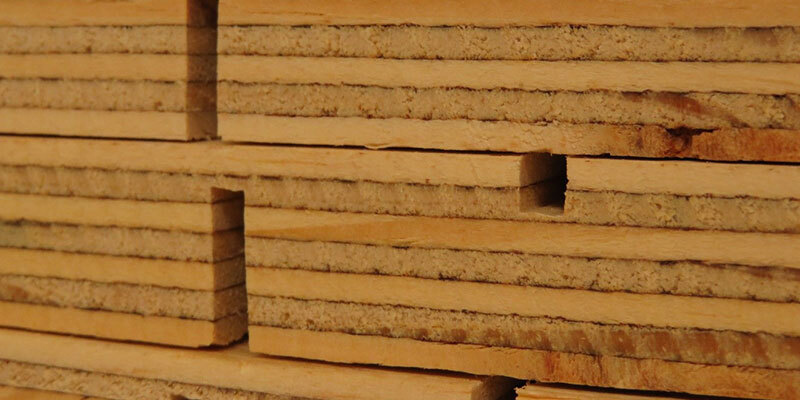
Contact our Timber Technical Helpline
01494 840 349BM TRADA has a timber testing laboratory and is UKAS accredited for plywood testing. Whether you are a plywood importer or distributor looking for additional conformity testing or have a project where plywood has failed prematurely in service, we can offer comprehensive testing and, if necessary, expert reports to suit your needs.
Available Plywood Grades
Customers often have questions regarding the grade and quality of plywood; to many, the grades can be confusing, particularly when old terminology for plywood is still frequently used by specifiers, suppliers and contractors.
There are currently a number of European Standards and British Standards which deal with plywood grades:
- General European Standards for plywood
- BS EN 635 (Parts 1 to 5), which deal with the visual appearance
- BS EN 636, which deals with the durability of adhesive bonds
- BS 1088 British Standard for Marine plywood
There are also several other standards which deal with testing and fabrication.
Most of the confusion, and the majority of testing work we undertake for clients, relates to glue bond durability rather than aesthetic appearance – our plywood testing services predominantly relate to ‘performance’ rather than ‘appearance’. However, we can comment on appearance grades if required.
Whilst it may initially appear overwhelming, only five plywood grades are available on the UK market. These are:
- BS EN 636-1 - Plywood with a Class 1 glue bond is only suitable for Use Class 1 applications (i.e. it will be fully protected from wetting and will be inside a building). These boards are typically used for the fabrication of interior furnishings.
- BS EN 636-2 - Plywood with a Class 2 glue bond is suitable for Use Class 2 (and 1) applications (i.e. it will normally be protected from wetting and the weather, but may be exposed to occasional short-term condensation or wetting). These boards are often used as floor decking, roof sarking and wall sheathing. Meaning it is expected that these will be protected from wetting but, due to leaks in the completed building or exposure to the weather during construction, must have some degree of tolerance to water.
- BS EN 636-3 - Plywood with a Class 3 glue bond is suitable for Use Class 3 (and 2 and 1) applications (i.e. it may be fully exposed to external conditions and weather, but it is not in ground contact). These boards are typically used as external cladding, site hoarding, signage and playground equipment.
- Class 2 and Class 3 plywood are available in non-structural (general) and structural grades. If boards are structural, they will be marked with an ‘S’ e.g. BS EN 636-2S.
It is important to understand that, in all cases, the grade of plywood relates to the durability of the adhesive used, and not the durability of the timber veneers. In exterior applications, plywood would need to be coated and/or preservative treated and/or maintained in order to provide the desired service life.
Marine Plywood is fabricated using Class 3 glue bonds (the same as those used in BS EN 636-3 plywood), but it is also fabricated using timber species with enhanced natural resistance to fungal decay. BS 1088 Marine Plywood is available in Standard and Lightweight grades depending on the density and durability of the timber species used. As part of a plywood manufacturer’s factory production control system, they should be undertaking glue bond testing on batches of plywood to monitor and confirm performance.
The European Standard for plywood glue bond testing is BS EN 314 (Parts 1 and 2). This testing is normally carried out by the manufacturer in their own laboratory and may be audited as part of any certification they hold. The majority of plywood testing that BM TRADA experts undertake relates to either failure of plywood in service or additional conformity testing for UK plywood importers.
Additional Testing for UK Importers
Some UK plywood importers/distributors choose to undertake additional plywood testing. The Timber Trade Federation requires their members to conduct third party testing to verify the quality and performance of certain types of plywood they place on the UK construction market.
Testing of Plywood in Service
Where plywood fails in service, laboratory testing can be undertaken to confirm whether the plywood was of the correct grade and of an appropriate quality. We have seen many examples of the wrong type of plywood used for roof decks or wall sheathing and/or plywood being of a poor quality. Plywood Testing BS EN 314 (parts 1 and 2) set out the methodology for plywood glue bond testing using the ‘shear test method’, where plywood test specimens are cut, exposed to moisture (pre-treatment protocol depends on grade) and then placed in a testing machine where the specimen is loaded in tension until failure. Once the specimen fails, both the failure load (in Newton per square millimetre) and failure mode (wood fibre failure or glue failure) are calculated and rated against minimum performance requirements.
Related Services
Q-Mark Marine Plywood Scheme
The Q-mark marine plywood certification scheme demonstrates compliance with BS 1088.
Related Information
Timber Training
Our experts provide a range of courses from visual strength grading through to scaffold boards and timber frame construction.
Training Courses
BM TRADA provides a range of training courses. Our training portfolio includes timber, fire, chain of custody, sustainable supply chain and business training.
Training Booking
Download our Training Booking Form.
Training Terms and Conditions
Read the Training Terms and Conditions.
Articles and Blogs
Access our library of technical articles and blogs to help you better understand our services and how we can help you.



